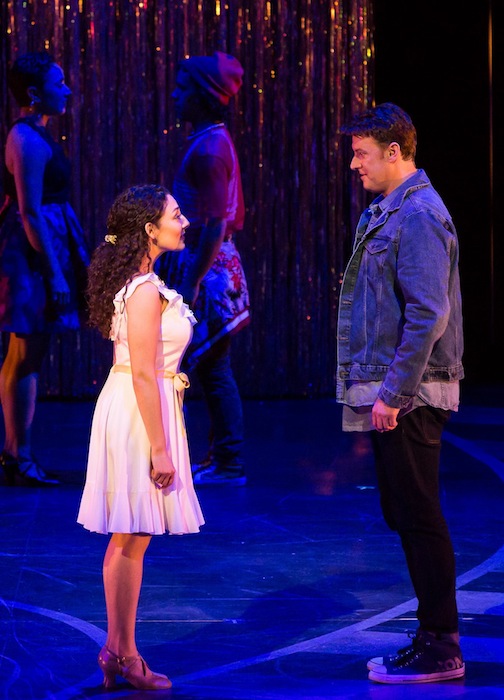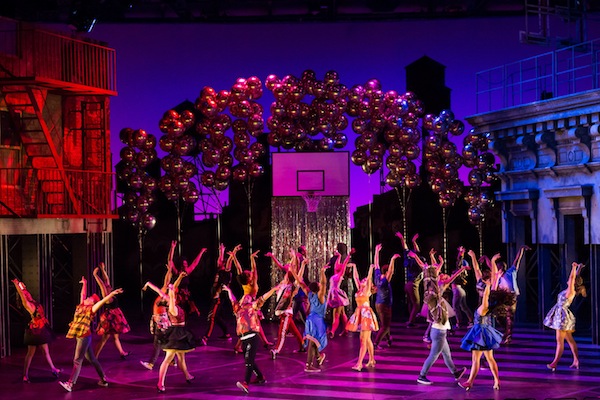HGO’s strong cast makes “West Side Story” a stylish success on the opera stage

Andrea Carroll is Maria and Norman Reinhardt is Tony in Houston Grand Operas’s production of Bernstein’s “West Side Story.” Photo: Lynn Lane
Houston Grand Opera bills its new production of Leonard Bernstein’s West Side Story as the Broadway classic’s first staging by “a major American opera company.” One wonders how much that really matters.
Yes, HGO has cast young singers from the opera world as Tony and Maria, West Side Story’s parallels to Romeo and Juliet, and some other main characters. But the show tells as much of its story through dancing–especially when it comes to the rival gangs’ confrontations–as it does through singing.
So HGO, rightly, has reached outside its usual circles for the bulk of the cast, enlisting young performers whose program bios invoke the likes of Chicago, A Chorus Line, In the Heights and Grease.
It’s the same story with the production’s leaders. Stage director Francesca Zambello works mainly in opera, and her HGO credits go back to 1984. But choreographer Julio Monge, here making his HGO debut, has deep roots on Broadway: He started his career working with West Side Story’s original choreographer, Jerome Robbins, and HGO’s program booklet says Monge is “bringing Robbins’ iconic West Side Story choreography to life” in this show.
What matter more than whether an opera company or a Broadway producer put it all together is the results, which are largely successful vocally in HGO’s West Side Story. The singers whose home turf is opera lend their richness and ardor–discreetly amplified–without overwhelming the show’s youthfulness or theatrical verve.
Friday night in the HGO Resilience Theater, tenor Norman Reinhardt–who played Tony opposite Cecilia Bartoli’s Maria at the Salzburg Festival in 2016–breezed through “Something’s Coming” with such lightness and zest that he might have passed for a Broadway native. He began “Maria” in an unprepossessing, almost conversational way. But when Bernstein’s melody took flight, Reinhardt’s voice swelled and soared in the best tradition of full-throated, free-flowing operatic expression. And he made the famous tense excitement of “Tonight” surge, too.
Reinhardt justifiably turned back from artifice toward realism as the story’s violence neared its climax: When Tony yelled for Chino from the rival gang to come and get him, Reinhardt shouted the challenge like it came from deep in his guts. That was one of the night’s most compelling moments.

Photo: Lynn Lane
While the full-fledged dancers delivered the high-powered Robbins choreography, Reinhardt and the rest of the cast’s operatic contingent got a boost from choreographer Monge, who gave them dance steps that suited their abilities,
Soprano Andrea Carroll cut an especially youthful figure as Maria. She filled “I Feel Pretty” with brightness and girlish whimsy. But she treated “Tonight” to lustrous tones that complemented Reinhardt’s ardor; when the restless gang members added their voices later in the Quintet, Reinhardt and Carroll’s voices rang out vibrantly above them.
“Somewhere” glowed, thanks to Carroll’s generous singing. And when Maria confronted the two gangs after Tony’s slaying, Carroll delivered her spoken soliloquy with a dramatic resolve that showed that she, like Reinhardt, didn’t need music to make an impact.
As Tony’s buddy Riff, baritone Brian Vu all but hid his operatic roots in the jazz-inflected “Cool”: Maybe the mellow sound would have been a tipoff, but Vu sang with a slinkiness and lithe energy that underlined the scene’s coiled-spring tension. And in Riff’s fatal knife fight with Bernardo, Maria’s brother, Vu handled his end of the dance-like brawl nimbly.
Gabrielle McClinton, as Maria’s bosom buddy Anita, took charge of “America.” Playing an immigrant who relishes her new home of Manhattan, McClinton–fresh from Chicago on Broadway–threw herself into the swaggering choreography and Anita’s lusty put-downs of the island she left behind. But McClinton’s voice sounded thin for “A Boy Like That,” Anita’s rebuke to Maria, and the number lacked its all-important dramatic impact.
As Bernardo, Maria’s brother and the leader of the Puerto Rican gang, DJ Petrosino wasn’t responsible for much solo singing. But the vigor and Latin-tinged gallantry of his dancing helped propel the ball at the gym and the gangs’ confrontations.
Mezzo-soprano Zoie Reams, the final member of the opera contingent, sounded completely at home in the earthy music Bernstein gave Maria’s pal Rosalia. Her heartiness added spirit to “I Feel Pretty”; her lushness brought out the sultriness of the salute to Puerto Rico that launched “America.”
Among the Jets, Tony’s onetime gang, Connor McRory as Action was an exuberant comic centerpiece in the mock-trial antics of “Officer Krupke.” And the rest of the performers in both gangs brought the choreography a vigor and fluency that put across not only aggression, but yearning and youthful high spirits.
Thomas Glass and David Matranga did tough-talking turns as the policemen Krupke and Schrank, respectively. Jack Young lashed out fiercely in Doc’s condemnation of violence. Fong Chau did a comic turn as Glad Hand, the social worker who can’t keep the dance at the gym under control.
Conductor Timothy Myers and the HGO Orchestra injected drive and impact into the fight scenes, as well as giving the lighthearted moments sparkle and bringing a moonlit gleam to Tony and Maria’s balcony scene.
Set designer Peter J. Davison condensed a New York street scene into a few movable pieces. In an especially adroit touch, he evoked bridges and homes with the same structures: Bridge supports at the bottom left room for the dancers to surge on- and offstage, and apartment-building exteriors above depicted the rest of the neighborhood, including the all-important fire escape.
The performance of course kept the original Arthur Laurents text with its sometimes dated 1950s lingo (like “Daddy-o”) that can make West Side Story a period piece to some degree. But to play up the timelessness of the show’s denunciation of violence, director Zambello and costume designer Jessica Jahn transplanted the show to the present day. The gang members and their girlfriends wore basketball jerseys, t-shirts, skinny jeans, knit caps and such.
The Jets are now a multicultural gang with Asians and blacks alongside the whites. But that raised a question that the show’s dialogue and lyrics couldn’t answer: If whites, blacks and Asians could all meld into one gang, what was so different about the Puerto Ricans that they couldn’t get along?
West Side Story runs through May 6 in the HGO Resilience Theater in Houston’s George R. Brown Convention Center. houstongrandopera.org
Posted Apr 23, 2018 at 4:23 am by Michael Benge
Is the reviewer suggesting that Black and Asian performers should be excluded from the cast, or that they should be thrown in to the Puerto Rican gang-the “PRs”- and the Sharks relabeled as “Undesirable Aliens”? That would be uncomfortably close to our current political narrative-somewhere HGO and most companies would fear to tread.